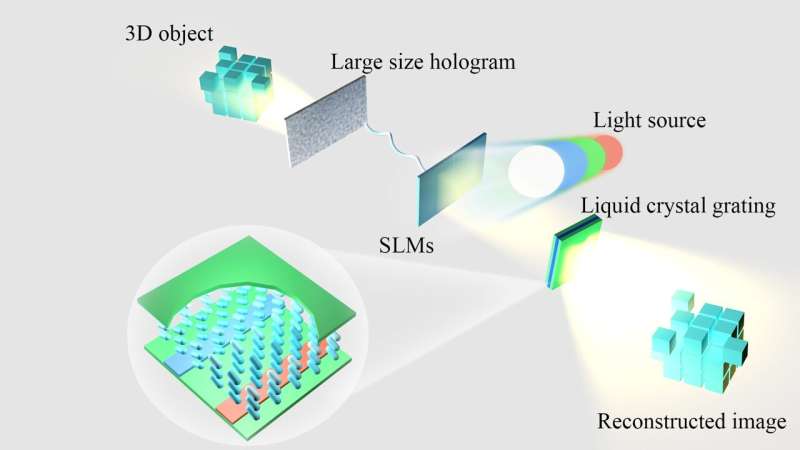This article has been reviewed according to Science X's editorial process and policies. Editors have highlighted the following attributes while ensuring the content's credibility:
fact-checked
trusted source
proofread
Attaining wider viewing angles for holographic 3D displays

The holographic 3D display is an important technology with excellent application prospects. However, the viewing angle of holographic 3D displays is currently limited by existing strategies. This significant challenge must be addressed before holographic 3D displays can be widely used.
In a new paper published in Light: Advanced Manufacturing, a team of scientists led by Professor Qiong-Hua Wang at Beihang University developed a new holographic 3D display with a wider viewing angle.
There are many methods to expand the viewing angle of the holographic 3D display. Typical approaches include using time or spatial multiplexing methods based on spatial light modulators (SLMs). However, these methods have limitations, such as high requirements for the refresh rate of SLM, an increased cost and complexity of the system.
Another approach is to control the volume speckle field to generate a holographic 3D image. This method has the potential to achieve a 60° display viewing angle. In addition, ultra-high-capacity aperiodic photon sieves and metasurface devices with sub-wavelength modulation capability have also been used to enlarge the viewing angle of holographic display systems.
These methods have shown promise in expanding the viewing angle of holographic 3D displays. However, challenges remain to be addressed, such as the need for high-speed SLMs and the demand for compact systems. Continued research is needed to develop holographic 3D displays with wider viewing angles and lower costs.
Liquid crystal devices have provided new opportunities for developing holographic 3D displays. These devices have the advantages of polarization selectivity and adjustable voltage, which can be used to expand the viewing angle of holographic 3D displays.
For example, researchers have used liquid crystal polymer-based Dammann gratings to expand the viewing angle of holographic near-eye 3D displays. Other researchers have used liquid crystal lenses to realize holographic zoom displays. In 2022, a tunable liquid crystal grating was used in a holographic display system, and the viewing angle of the system reached 57.4°.
However, the diffraction of image points in the previously proposed system did not fully reach the maximum diffraction range of the SLM. This means that there is still room for improvement in this technology.
A large viewing angle holographic 3D display system is proposed. The core of this system comprises the SLMs on which a large-size hologram is loaded and liquid crystal grating. A maximum diffraction modulation scheme is proposed to enlarge the viewing angle.
For a 3D object, the maximum diffraction fringe of each image point can be obtained by determining the effective viewing area of the reconstructed image under the limited diffraction condition of SLM. Based on this, the calculation method of the large-size hologram is proposed. Liquid crystal grating has a special structure, which can provide the secondary diffraction of the reconstructed image to realize the continuous expansion of the holographic viewing angle.
The proposed maximum diffraction modulation scheme enables the viewing angle of the system to be enlarged considerably. The proposed approach has a decent display effect and broad application prospects.
In conclusion, a large viewing angle holographic 3D display system is proposed. The method comprises two key components: SLMs and liquid crystal grating. By assuming the maximum diffraction angle of the SLM as the limited diffraction modulation range of each image point, the large-size hologram of the object can be obtained. The liquid crystal grating is then used to perform secondary diffraction modulation on the reconstructed image, which enables the continuous expansion of the holographic viewing angle.
Theoretical and experimental results demonstrate that the proposed system achieves a large viewing angle of 73.4°. This significantly improves over the previously proposed holographic 3D display system, which has viewing angles of less than 60°. The proposed system is expected to promote the applications of holographic 3D displays in a wide range of fields, such as education, entertainment, and medicine.
More information: Di Wang et al, Large viewing angle holographic 3D display system based on maximum diffraction modulation, Light: Advanced Manufacturing (2023). DOI: 10.37188/lam.2023.018
Provided by Chinese Academy of Sciences


















